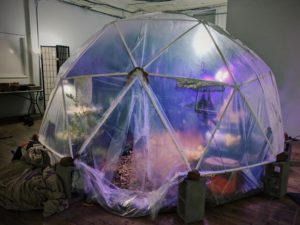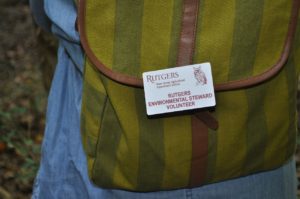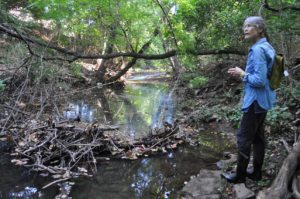Message and photos by Jamie Bruno.
Editor’s Note: The LRWP and coLAB arts are pleased to welcome Jamie Bruno to our work in New Brunswick. Jamie will join us for the next 9 months as our National Endowment for the Arts Resident Artist.

Hello Dear Reader. Happy to be writing to you today.
As the new Resident Artist with the Lower Raritan Watershed Partnership my work is to bring people to the river and bring the river to people. Increasing that knowledge and access increases people’s value of a healthy river and watershed. Much of my work will be dedicated to CoLAB Arts and LRWP’s existing programming such as Rail-Arts-River and Trash Troubadour, within which the already incredible experience of cleaning up a stream also becomes an experience in arts and culture.
I live in Newark, NJ. My most recent work has been focused around urban agriculture, food security, food waste management, and organizing for urban agriculture alliance development. I manage a small farmers market for a local nonprofit once a week at a hospital in Newark. My most recent artwork, “And all our dead can live again,” is a functioning geodesic dome that, in many ways, is a reaction to doing urban agriculture and local food development work in a post-industrial inner city.

All Our Dead Can Live Again
As a graduate of Rutgers Mason Gross School of the Arts, I am already familiar with New Brunswick though I am still orienting to this new position and a changed city. My eyes see the river differently from the scientists, geologists and academics who study it. Slowly I will see more. For now I notice the strange interactions between humans and the human built riverfront. On my first trip re-visiting Boyd Park I see moments of departure in the landscape by an uncooperative nature, consistently unconcerned with our good intentions. And neglect by us, to simply sit and listen to her. I can’t wait to tell you more about that visit.
You don’t know me and I will only be with you, officially, for a short nine months. But within that nine months I hope that we can make sweet, passionate earth caring goodness together. Earth Care. People care. Future care. In the incredibly succinct lyrics of M.I.A.’s song “Meds and Feds”: We just “give a damn,” and, another inspiration, Y.A.L.A. (You Always Live Again as opposed to the formerly popular phrase, Y.O.L.O., You Only Live Once)… Earth karma.
Thank you for reading. If you’d like to see more of my work please visit tothedirt.net
The Nature Conservancy recently asked the Lower Raritan Watershed Partnership to identify the top issues facing the communities with which we work. We developed our “Top 10” list, below.
A few caveats to this list. First, the Lower Raritan Watershed is comprised of a diversity of communities facing a varied set of issues. Each community would likely identify a different set of priority issues. Second, the LRWP has not conducted a comprehensive survey of need (although it is something we would like to do). The following issues have been identified during discussions with communities, by daily culling of google for Raritan River and watershed-related news stories, reading minutes from Environmental Commission, and from general observation. Many of these issues are inter-related, but we have culled them out as they often seem to be discussed singly.
We very much welcome stakeholder comments, input and suggestions to the add to our list.
- Substandard quality of area waters due to toxic contamination and contamination due to disease-causing pathogens. This bears not only on fishing, swimming and secondary contact, but also on concerns with drinking water quality.
- Uncertainty regarding the quality of area waters: lack of readily accessible (and easily interpreted) information about water quality.
- Linked to, but distinct from the above: the need for restoration of historic contaminated sites and waterways to protect public health.
- Sea level rise, and assistance with preparedness / resiliency planning.
- Flooding, significant impervious surfaces, and disruption of natural / historic hydrologic flows.
- Stormwater runoff and the need for regional stormwater management, including assistance with meeting MS4 requirements from County/state or other regional entity.
- Fragmentation of habitat, including fragmentation of human scale habitat (e.g. walking and bicycling routes).
- Perceptions of safety around riverfront spaces and streams deters use of these spaces (e.g. significant homeless populations, poor lighting, limited access and/or limited signage).
- Aging rail infrastructure that could lead to devastating spills in our waterways.
- Threat of pipelines or other significant infrastructure that might damage habitat.
Photos and article by Michele Bakacs, Environmental and Resource Management Agent, Cooperative Extension of Middlesex County, Rutgers New Jersey Agricultural Experiment Station

Through a relatively new program sponsored by Rutgers University Cooperative Extension, citizens throughout the Lower Raritan Watershed are working to help people discover the hidden natural world flowing through their communities. These citizens are part of the Rutgers Environmental Steward program and their projects range from conducting stream habitat assessments to developing middle school illustration lessons highlighting the flora and fauna of the watershed.
The goal of the Rutgers Environmental Steward program is to help citizens understand the science behind pressing environmental issues and help create positive environmental change in their communities. Susan Edmunds from Highland Park is one such Environmental Steward working on assessing the health of Mill Brook, a tributary of the Lower Raritan River.
“My goal is to bring an awareness of the Mill Brook to the community so we can work to protect it and use it as an asset. I have realized the most important thing to do is just talk to people about the brook. So many people just don’t know it is there. It would be nice to be able to take a stroll along the brook in some of the already existing parks.”
One morning in September, we scramble down a steep ravine and climb down over branches to the brook. The brook is hidden behind chain link fences, railroad overpasses, and overgrown vegetation. Once you are there you can’t believe how beautiful it is. We are transported to a natural world where the gurgling stream winds its way past towering locusts and silver maple canopy trees, and through sandstone and shale outcrops. Of course we see garbage and dumping typical of every urban waterway- the stereotypical abandoned tire and shopping cart, down trees across the stream collecting trash showing you just how damaging plastic water bottles can be to our environment when not disposed of properly. But except for the occasional train coming by as a reminder, you can barely tell how close we are to houses, roads, and train tracks. There’s the sounds of birds, leaves blowing, shadows and sunlight peaking through the trees on the water. The brook is a hidden gem waiting to be discovered by anyone who makes the effort to find it.
“The Environmental Stewards program was exactly what I hoped it would be in that I gave me a way to start getting involved with environmental protection in my community.”

Environmental Steward Susan Edmunds Assesses Mill Brook
Mapping Mill Brook is the project Susan chose for her Rutgers Environmental Steward internship. After attending about 60 hours of classes that start in January and run through June, Stewards complete an internship project of their choosing in order to become a certified Rutgers Environmental Stewards. The program welcomes non-scientists and links them with members of the academic community, government, and non-profits. The curriculum includes classes, field trips, and an internship. Once Susan is done mapping her section of Mill Brook she will summarize her findings for the Lower Raritan Watershed Partnership who will use her work to prioritize sections of the Lower Raritan for monitoring, restoration, and clean up.
“Already this project has connected me with so many people who are just like me in that they want to clean up this stream. From this assessment I plan to create a presentation about the brook and its history. I am excited about the potential for a Friends of the Mill Brook group working together towards stream access. This assessment is just the beginning of my journey.”
During the assessment, Susan takes pictures of deteriorating culverts, tree snags that collect garbage and stormdrain outfalls- concrete pipes that empty the rainwater runoff from local roads into the stream. We walk into a steep ravine probably 25 feet high with sandstone and shale outcrops leading to a large culvert where the stream flows under the NJTransit’s train tracks. This ends today’s journey and we turn around to make our way back to civilization.
If you are like Susan, and looking to start your own journey helping to protect the local environment, then sign up for the 2017 Rutgers Environmental Stewards class. Classes start in January in 5 counties throughout the state including Middlesex County at the EARTH Center in South Brunswick, and Somerset County at Duke Farms. For more information contact Michele Bakacs, at 732-398-5274, mbakacs@rutgers.edu, or visit our website http://envirostewards.rutgers.edu/




